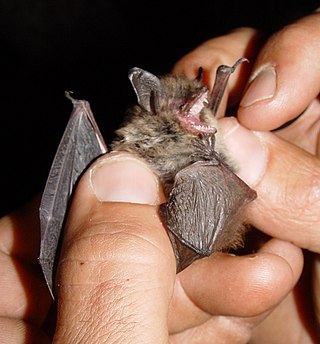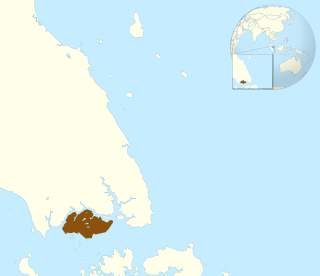
The mouse-eared bats or myotises are a diverse and widespread genus (Myotis) of bats within the family Vespertilionidae. The noun "myotis" itself is a Neo-Latin construction, from the Greek "muós and "oûs", literally translating to "mouse-eared".

The fraternal myotis is a species of vesper bat native to East Asia.

Hodgson's bat, also called the copper-winged bat or black-and-orange myotis, is a species of vesper bat in the genus Myotis, the mouse-eared bats. Favouring mountain forests, it is found throughout Central, Southeast, and East Asia, from Afghanistan to Taiwan. It is about 5 centimetres (2.0 in) long and is distinguished from most other species of bat in this range by its yellowish colouration.
The Csorba's mouse-eared bat is a species of vesper bat. It is found only in Nepal.

The fringed long-footed myotis is a species of vesper bat in the family Vespertilionidae. It is found in China, Taiwan and Hong Kong.

The Burmese whiskered myotis or Burmese whiskered bat is a species of vesper bat. It is found in China, India, Myanmar, Laos, and Vietnam.

The Singapore whiskered bat is or was a possible species of vesper bat endemic to Singapore. No specimens have been found since its original scientific description in 1840 by Dutch zoologist Coenraad Temminck.
The Taiwan broad-muzzled bat or Taiwan broad-muzzled myotis is a species of vesper bat found in Taiwan.

Myotis indochinensis, commonly known as the Indochinese mouse-eared bat, is a species of cave-dwelling bat in the family Vespertilionidae. It is found in Vietnam and China.

The Oriental serotine is a species of bat in the family Vespertilionidae. It is widespread and found throughout Asia.
The reddish myotis is a species of vesper bat. It is endemic to Taiwan.

The long-toed myotis or Taiwan long-toed myotis is a species of vesper bat endemic to Taiwan.

The Siberian bat or Siberian whiskered myotis is a species of vesper bat in the family Vespertilionidae. It is found throughout northeastern Asia, primarily in Siberia. It is known for its high life expectancy relative to its body size, approximately twice that of humans, and holds the record for the oldest bat; in 2005, one individual was discovered in a cave in Siberia that had been banded in 1964, making the bat at least 41 years old.

The reddish-black myotis or black-winged myotis, colloquially known as the "red bat" or "golden bat" in South Korea, is a species of vesper bat found throughout East Asia.
Weber's myotis is a species of vesper bat endemic to the Indonesian island of Sulawesi.

Peyton's myotis, also known as Peyton's whiskered bat, is a species of vesper bat endemic to India.

The Malaysian whiskered myotis or Malayan whiskered myotis is a species of vesper bat endemic to Malaysia, although it may possibly also occur in Indonesia.

The Bornean whiskered myotis is a species of vesper bat endemic to Borneo.

The long-tailed myotis is a species of vesper bat found in northern and eastern Asia.

Dinelli's myotis is a species of vesper bat found in southern South America.















